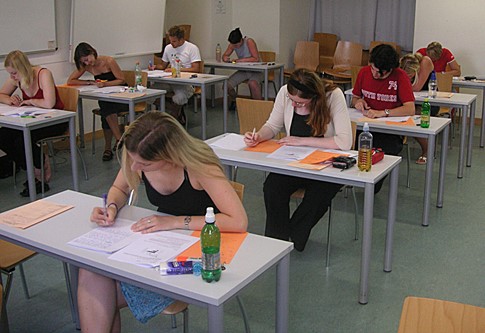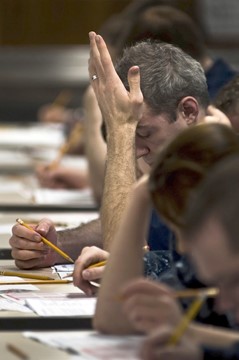Learning Task 6: Taking and Preparing for Tests
Click play on the following audio player to listen along as you read this section.
Effective Techniques for Taking and Preparing for Tests
Preparing to take exams and tests starts with planning. Be sure you have the answers to the following questions for every quiz, test, and exam you have to take, and note the information down in your schedule and notes:
- When is the quiz, test, or exam, where will it be held, and how long will it be?
- How much is it worth in your final mark?
- What topics will be covered?
- What format will it be (e.g., multiple choice, short answer)?
- Will there be any pre-exam review or study sessions (if so when and where)?

Having answers to the above questions will let you plan for each test appropriately and make sure that you budget sufficient study time for each. For example, a quiz worth 1% will require significantly less study time than a final exam worth 50% of your overall mark.
Here are some other strategies for effective planning for test preparation and writing:
- Pay special attention to the information provided by the instructor. This information maybe given orally (which means you will need to transcribe the information in note form) or may be printed on handouts. If you are not sure about something, make sure to ask your instructor for clarification.
- If there are any review or student sessions, make sure that you attend. If you are unable to attend, be proactive and get copies of any notes or handouts from your instructor or a classmate.
- Study for the exam based on the exam format. For example, if you know that your exam will consist of problem-solving and multiple-choice questions, build these two types of questions into your studying. You should be able to find many examples of these kinds of problems in your textbooks, homework assignments, or previous tests and quizzes. Redo any related multiple-choice assignments you might have received in class or create your own tests to challenge your knowledge.
- For larger tests or exams, plan out your study time over several days or weeks. Don’t procrastinate or try to cram your studying into the last minute.
- Get a good night’s sleep before the exam. Set out all the materials, supplies, and identification you need to take to the exam the night before the exam. For example, make sure you’ve got ample sharpened pencils and erasers. If you are allowed to bring in one page of formulas and information, make sure that is well organized and legible.
- Eat properly before the exam. It’s hard to focus if you are hungry, particularly if you didn’t have a good night’s sleep.
- The day of the quiz, test, or exam, leave home earlier than usual, use the washroom, and try to show up at least 10 to 15 minutes before the exam starts.
- Leave any items not allowed in the exam room in your locker, car, or the location identified by your instructor or the exam invigilator. If you have a cell phone, turn it off.
- Show up to the exam relaxed and with a positive attitude. (Often this comes from knowing that you’ve put in the necessary study time.)
- If you have a choice where to sit, choose a comfortable location and set up your desk so that you are ready to start. Check if there is a clock at the front of the classroom so you can keep track of time.
- Listen carefully to the instructions at the start of the exam.
- If you feel yourself becoming nervous, use strategies to help you relax, such as taking deep breaths or changing your position in your seat.
- Keep your eyes on your own exam.
- Pace yourself. Don’t worry if other students finish earlier than you do and leave the exam room before you are finished.
- Make one final check before handing in the exam to ensure that all personal information required has been completed.
![]() Watch the video: Exam Tips: How to Study for Finals – College Info Geek (6 minutes)
Watch the video: Exam Tips: How to Study for Finals – College Info Geek (6 minutes)
![]() Watch the video: 10 Ways to Avoid Making Stupid Mistakes on Exams – College Info Geek (5 minutes)
Watch the video: 10 Ways to Avoid Making Stupid Mistakes on Exams – College Info Geek (5 minutes)
Tips for Multiple-Choice Tests
The majority of your tests and exams in trades will be in multiple-choice format. The following are just a few tips to help you when completing multiple-choice exams:
- Read any exam instructions carefully before you begin to answer questions.
- Fill in the paper exam sheet or computerized test according to the instructions.
- Read over each question slowly and carefully and know exactly what is being asked. You may want to read the question a second time before proceeding.
- If a question is long, break it into separate parts so it is easier to understand.
- Look for any tricks or wording meant to throw you off the correct answer. For example, watch out for negatives in a question, such as “Which is not the correct answer?”
- Try to come up with the answer in your head before reading all the choices.
- Even if you think you know the answer, read all the choices to make sure you select the correct one.
- Often your first choice is your best choice. Don’t second guess yourself and change answers repeatedly.
- Complete all of the questions you know the answers to first. Then return to the questions that you don’t know.
- If you don’t know the correct answer, go through each choice and eliminate the ones that you know are wrong. Through the process of elimination, you may come up with the correct answer or reduce the number of choices in order to make an educated guess.
- Answer every question. An educated guess is better than no answer at all.
- If you have time left over at the end of the exam, review the test to make sure you’ve answered all questions.
- If your exam requires you to use formulas that you have memorized, you may want to jot them down on a piece of paper at the start of the exam. This way you can easily retrieve the formulas when you need them for specific questions.
- If you have time, review your answers a final time. Provided you’ve understood the question the first time you read through it, you should be making very few corrections at this stage.
- Check that your name and any other information required on the exam are completed before handing it in.
Test Anxiety
Most students have some anxiety or stress before taking a test or final exam. One of the ways in which you can reduce test anxiety significantly is to be prepared. The more effective studying and preparation you do ahead of time, the greater the likelihood you’ll be able to keep your anxiety level down. Try to keep a positive attitude throughout your studies and in the exam. A negative attitude can be self-defeating and greatly increase your level of anxiety.

If you have a major problem with text anxiety, it can affect your health and performance. You may want to find out more about the services available at your institution to help you deal with this issue. Be proactive, and don’t wait until the last minute to ask for help.
![]() Now complete the Learning Task Self-Test.
Now complete the Learning Task Self-Test.
Self-Test
Self-Test 6
- Preparing to take exams and tests starts with planning.
- True
- False
- What is the best source for information on an exam?
- Your instructor
- Your friends or students who have taken the program in the past
- All of the above
- None of the above
- How many times is it recommended that you read over a question before attempting to answer it?
- Once
- At least twice
- As many times as you need to before moving on to the next question
- Three times, and if you don’t understand it, then move on to the next question
- How can stress or anxiety be decreased before taking a test?
- Having a negative attitude
- Cramming at the last minute
- Leaving the outcome up to fate
- Being prepared and getting a good night’s sleep
- If you know the exam will be multiple choice, you should practice multiple choice questions from your study material.
- True
- False
See the Answer Key in the back matter of the textbook for self-test answers.
Media Attributions
- “Line B-1: Learning Task 6” was recorded by BCcampus based on text written by Camosun College and licensed under a CC BY 4.0 licence.
- “Test (student assessment)“ by KF is in the public domain.
- “R” icon by Nathan David Smith is licensed under a CC BY 3.0 licence.
- “Exam Tips: How to Study for Finals – College Info Geek” video by Thomas Frank is licensed under the Standard YouTube licence.
- “10 Ways to Avoid Making Stupid Mistakes on Exams – College Info Geek” video by Thomas Frank is licensed under the Standard YouTube licence.
- “Sailors take their advancement exams“ by U.S. Navy is in the public domain.
- “Tick” icon by Lars Meiertoberens is licensed under a CC BY 3.0 licence.

